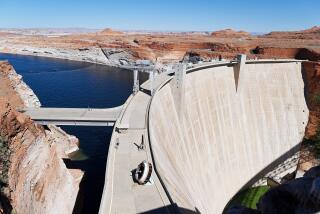Oroville Dam spillway had two dozen problems that may have led to mass failure, report says

If the state keeps sending water down the spillway, it will worsen the damage. (Feb. 9, 2017)
The massive failure of the Oroville Dam’s main spillway in February involved two dozen potential design and maintenance problems, including thin concrete, inadequate reinforcing steel and weaknesses in the foundation, a panel of engineering experts reported Wednesday.
A forensic investigation team said it was issuing a preliminary list of causes so that engineers do not repeat the problems as they rush to fix the spillway before the next cycle of rains begins in November.
The two-page report does not identify what initiated the failure along the 3,000-foot chute that was used to drain the reservoir during massive winter storms. But it makes clear that the spillway is structurally too weak to handle the massive loads it sustained when dam operators opened the spill gates.
“The list is long,” said David Gutierrez, one of state’s top dam safety experts who retired from the Department of Water Resources after 37 years and is now consulting on the safety investigation. He said that not all of the 24 factors will likely be cited as causing the failure, but he added that no single problem likely caused the failure either.
“You wouldn’t design it today as you would back then,” Gutierrez said.
The Federal Energy Regulatory Commission, which has oversight of Oroville Dam, ordered the Department of Water Resources to conduct an official investigation, which began in March with the six-member forensic team.
They didn’t mention people. Root causes involve people. God didn’t design those slabs.
— Robert Bea, risk management consultant
The spillway is a key part of the dam, allowing large discharges of water when the reservoir is nearly full.
It began failing Feb. 7 when dam operators opened gates that sent 55,000 cubic feet of water per second roaring out of the reservoir after days of continuous rain drenched the Feather River watershed. That amount is a fraction of the spillway’s designed capacity of 300,000 cubic feet per second.
The entire lower section of the spillway eroded away, and the rushing water then eroded soft rock on the slope. Gutierrez said that section will be rebuilt this year, and the upper section of the spillway will likely be replaced next year.
The repairs for all the damage will cost about $500 million.
Oroville Dam operators began using the damaged spillway again at 9 a.m. Wednesday and will continue discharges for the next 10 to 15 days. They hope that will be the last time the spillway is needed until next fall, so that construction crews can move in equipment and start rebuilding the structure.
The reservoir can also be lowered by discharges through the dam’s power plant, but one of the two power plant outlets, known as penstocks, was shut down for routine maintenance of turbines. That should be reopened by late May, allowing dam operators to control the reservoir level as the Sierra Nevada snowpack melts this summer.
The forensic team report covers design, maintenance and operation factors as possible causes of the failure.
Among the problems the report identified:
- large variations in the thickness of the spillway’s slabs
- lack of continuous reinforcement along slab joints
- slabs that were too large to control cracking
- slab joints that allowed water to penetrate
- hydraulic pressures that were transmitted to beneath the slab
- multiple problems with drains under the slab that were supposed to relieve upward pressure
- inadequate preparation of the foundation and lack of effective repairs through the years
The forensic team also identified potential factors in the damage to Oroville’s emergency spillway, an unpaved hillside that was briefly used in February when the main spillway was damaged.
Robert Bea, a UC Berkeley professor emeritus and co-founder of the school’s Center for Catastrophic Risk Management, issued an independent analysis last month that included many of the factors that the forensic team identified.
In an interview Wednesday, Bea criticized the state report for its failure to identify the human factors that were at the root of the design and maintenance errors.
“They didn’t mention people,” Bea said. “Root causes involve people. God didn’t design those slabs.”
You wouldn’t design it today as you would back then.
— David Gutierrez, dam safety expert
Bea said the forensic team consisted of top technical engineers with extensive experience in dam safety but lacked anybody specialized in organizational issues.
The dam design dates back to the 1960s, when safety standards were far different from today. Government organizations, ranging from NASA to the Army Corps of Engineers, have found technical failures can often be traced back to flaws in an organization’s safety culture.
“It is hard to blame yourself,” said Bea, who is scheduled to testify today at a legislative hearing on the Oroville failure. “There are all of these human defensive reactions that go up.”
Follow me on Twitter @rvartabedian
More to Read
Sign up for Essential California
The most important California stories and recommendations in your inbox every morning.
You may occasionally receive promotional content from the Los Angeles Times.










